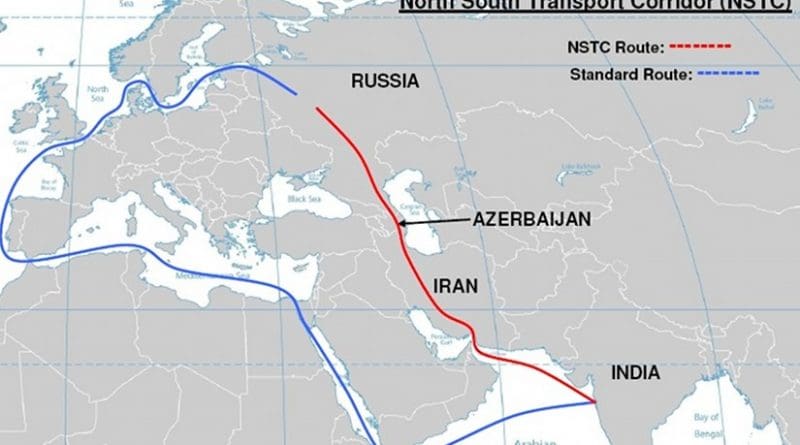North-South International Corridor: A Factor To Boost Iran’s Regional Standing – OpEd
By Iran Review
By Bahram Amir-Ahmadian*
Iran’s position as a regional crossroads is a very valuable potential which is pointed out in most viewpoints on Iran, both by Iranians and non-Iranians.
Iran’s infrastructural facilities for road and rail transportation as well as its ports and trade services such as onloading and offloading, storage and distribution enjoy good potential, but the degree to which they have been used has not been adequate to promote Iran’s geographical position to a geopolitical position and lead to desirable development in the country and job creation. The North-South International Corridor is a potential that has received less attention than it deserves and under the present circumstances the need for paying more attention to it is felt more than before.
The international North-South Corridor was first introduced in 2000 by Russia, India and Iran with the goal of establishing a shorter route compared to the present transport corridor that passes through the Suez Canal in order to reduce transportation time and decrease costs of commodity trade. Later on, Belarus, Kazakhstan, Tajikistan, Oman, Armenia, the Republic of Azerbaijan, Ukraine, Kyrgyzstan and Turkey joined the project.
Some factors have prevented progress of this project in the past 15 years. Mounting economic pressure on Iran by the United States and the member states of the European Union over Iran’s nuclear program, which started in early 2000s, Russia’s unwillingness to be an active partner to this process, and India’s reluctance to take practical steps for investment in the project have been among major factors that have prevented progress of the project.
Now, as Western sanctions against Iran are to be removed, the country is able to once again activate the corridor. Activation of the corridor will lead to increased trade exchanges in the region, activation of Iran’s trade services and promotion of Iran’s position in the region.
Goals and purposes
The goals and purposes sought through the implementation of the North-South International Corridor project include:
- Development of transportation ties among involved countries in order to organize transport of goods and passengers along the North-South International Corridor;
- Increased access by involved countries to global markets through facilitation of rail, road, maritime, river, and air transportation;
- Helping to increase the volume of international transport of goods and passengers;
- Ensuring security of traveling, safety of products, and protection of environment in accordance with relevant international standards;
- Coordinating transportation policies and formulating necessary transport rules and regulations to implement this agreement; and
- Providing suitable conditions for suppliers of all kinds of goods and passenger transport services in involved countries within framework of the North-South International Corridor.
Investment made in implementing the North-South International Corridor project:
- Investment made by the United Arab Emirates includes building freight ships for the Persian Gulf in addition to building necessary docks for them and construction of a railroad station at Dubai port;
- Investment made by Iran includes construction of freight docks in Bandar Abbas port city and construction of their jetties at Shahid Rajaei port in Bandar Abbas city in addition to construction of similar docks in Amirabad port and building a train station in Amirabad port;
- Investment made by the Russian Federation includes construction of port and infrastructural facilities in Lagan town, construction of freight docks in Lagan town, building 34 freight ships for navigation in the Caspian Sea, and building four towboats for container cargos.
Attention should be also paid to the implementation of the following plans within framework of the North-South International Corridor project:
- Improvement and development of managerial structures of the corridor;
- Union among project member within its regulations;
- Attention by governments to infrastructural necessities; and
- Increased volume of cargo transport through all routes and in both directions.
From a geopolitical viewpoint, transportation of goods through the North-South Corridor will not only have many benefits for Iran, but will also strengthen Iran’s standing in the Caspian Sea region because Iran plays a central role in this corridor. From a strategic viewpoint, this corridor can be used when critical conditions govern international waters and cause problems for shipping, and as such, guarantee continuation of the free flow of goods. Since Iran is a gravitational center in this corridor, activation of the corridor will have many benefits for our country. This mechanism is one way to turn Iran’s geographical position into a geopolitical position.
*Bahram Amir-Ahmadian
Tehran University Professor & Researcher at the Institute for Trade Studies and Research
Source: Khabaronline News Website
http://www.khabaronline.ir/
Translated By: Iran Review.Org


The EBRD and the Asian Developmrnt Bank are sponsoring the construction of a north-south highway thru Armenia which connects Iran to Georgia. Some portion of the highway is already built and the rest is in progress.